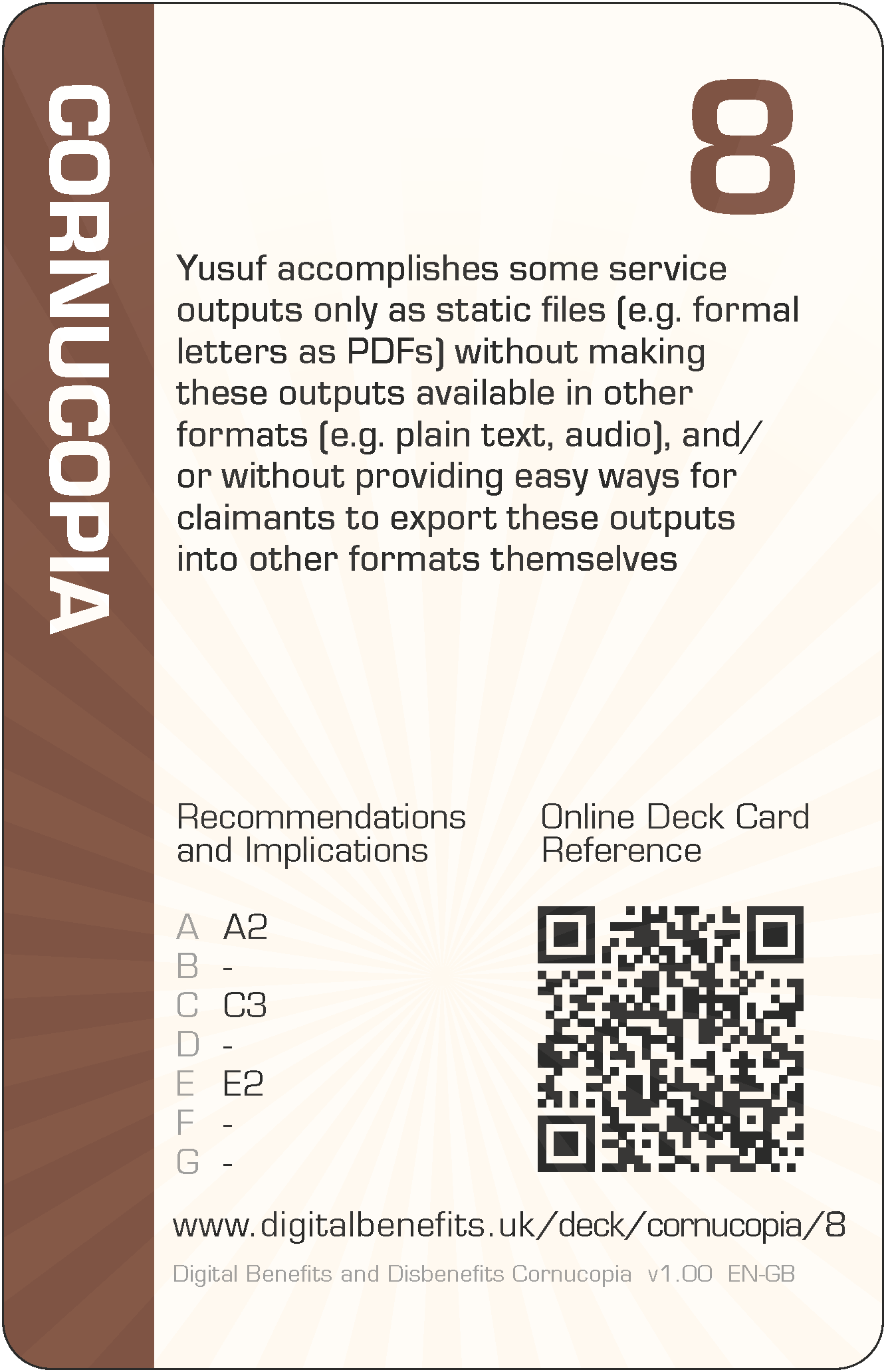Cornucopia 8 (CO-8) Card
DBD Cornucopia > Deck > Cornucopia > 8
Card Details - Eight of Cornucopia
Abbreviation
CO-8
Card's focus
The focus of this card is document formats
Threat to claimants
Yusuf accomplishes some service outputs only as static files (e.g. formal letters as PDFs) without making these outputs available in other formats (e.g. plain text, audio), and/or without providing easy ways for claimants to export these outputs into other formats themselves

Threat to claimants
Yusuf accomplishes some service outputs only as static files (e.g. formal letters as PDFs) without making these outputs available in other formats (e.g. plain text, audio), and/or without providing easy ways for claimants to export these outputs into other formats themselves.
Some examples of how this threat could lead to harms (negative effects on claimants)
The design recommendations and implications relevant to the card are listed below in the next section, but even those can be somewhat abstract and difficult to think about during practical day-to-day implementation. Therefore, some example harms are provided to complement the more formal research outputs. These examples are unique per card, and are only published on these web pages (i.e. in no other project outputs).
- Claimants have great difficulty downloading PDFs due to poor mobile signal in their village leading to them being under-informed about their claims and their ongoing commitments, increasing the risk of sanctions
- Claimants have difficulty reading documents on small screens and no way to print anything, leading to missed instructions and then their claim being closed unexpectedly
- The generated PDFs have very poor accessibility, making it impossible to convert them to meaningful plain text or audio, and therefore requiring someone else to help claimants every time a PDF is received
The examples are to help understand the threat on the card, not to suppress thinking and innovation. Incorporating these examples exactly, or closely matching ones, should be scored down when playing DBD Cornucopia as a game.
Applicable design recommendations and implications
These are reproduced here from Research Briefing N
Support claimants’ own ecosystems
- Generate structured data for visibility and re-use by claimants and other actors
Provide, signpost and explain functionalities to span the fullest range of claimant activities, so as to reduce the need for and use of messaging/chat interactions (like the UC Journal) which result in unstructured data. Ensure the structured data enables re-use to increase wider ecosystem efficiencies: provide for recording and keeping full records of every interaction by every channel (including files, form submissions, all communications), and provide methods to ensure information can be found and referred to, and easily exported or shared with others as required.
Reduce claimants’ interaction burdens with digital welfare
- Provide full social protection services across wider interoperable channels
Ensure all service provision and modes of assistance (e.g., provision of advice, practical support and self-help guidance) are available through multiple interaction channels (e.g., telephone, web, mobile app) which are accessible to varying resources and capabilities (e.g., communication skills, equipment, language, physical and mental abilities). Permit the use and intermixing of channels without restriction. Consider providing on-demand synchronous interactions through digital as well as other channels.
Design systems which support the division of labour with claimants' ecosystems
- Expand claimant autonomy, control and choice, backed up by transparency of actions and activities
Enable claimants to better engage with digital welfare and empower them to make their own choices and decisions. Attribute information sources, other advice and decisions; build in logging and audit trail generation; provide access to records of what information was used to make choices/decisions and by whom; provide mechanisms for claimants to question, discuss and challenge actions, provide feedback, and make complaints.
General Notes
Card values (i.e. '8' for this card) are for game play and are not correlated with the severity of harm. This is because threats cannot be ranked directly since they can affect individuals in different ways due to situations and circumstances, or affect fewer or more claimants, or the harms can arise in claimants' support networks and wider society.
The threat description uses a person's name as the "attacker" (i.e. 'Yusuf' for this card), which can be thought of someone involved with implementation. They could have any role which influence digitisation. So they could be a database administrator, or a copy writer, or a quality assurance specialist, etc, or all of these. Everyone could have some influence on the claimant threat described. The names were randomly selected from those currently most popular as given names for boys and girls (UK Office for National Statistics).
The example harms provided are drawn from the research data (which explored not only parts of existing services but also the effects of possible changes to those), from the author's own knowledge of web application development and testing, the author's own experience of helping citizens to claim Universal Credit (UC) and Personal Independence Payment (PIP), and from suggestions submitted by other people (make a suggestion). The threats and example harms do not necessarily exist in the current UC or PIP deployments or in ecosystems around those services, but they might well do.
All the cards in this Cornucopia suit are: 2 3 4 5 6 7 8 9 10 J Q K A
The other suits in the deck are: Scope, Architecture, Agency, Trust and Porosity (plus Jokers).
